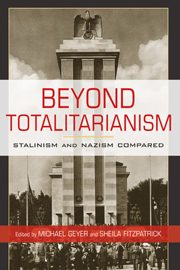9 - States of Exception
The Nazi-Soviet War as a System of Violence, 1939–1945
Published online by Cambridge University Press: 05 June 2012
Summary
Step forward: We hear that you are a good man.…Listen, we know you are our enemy. Therefore we now shall put you against a wall. But in consideration of your merits and virtues, it will be a good wall, and we shall shoot you with good bullets from good guns, and we shall bury you with a good shovel in good soil.
(Bertolt Brecht, “Verhör des Guten”)And as to you, when the time has come that man will be his brother's keeper, look back on us with forbearance.
(Bertolt Brecht, “An die Nachgeborenen”)The trouble is that neither the Wehrmacht nor the Red Army considered merit and virtue and, inasmuch as they buried the dead, they did not bury them in good soil. Neither did those born afterward show forbearance, for they were either too caught up in the dark times they tried to escape after defeat or never saw the darkness in the bright light of victory. The Soviet Union and the German Reich fought a war that denied virtue and honor to enemy soldiers and set entire people against each other in a life-and-death struggle. Memorializing the war did not bring, or has not brought yet, together what the war had torn asunder. In the new century, there are some indications that the time for forbearance or, in any case, for commemoration in the spirit of mutuality may yet come.
- Type
- Chapter
- Information
- Beyond TotalitarianismStalinism and Nazism Compared, pp. 345 - 395Publisher: Cambridge University PressPrint publication year: 2008
References
- 1
- Cited by

